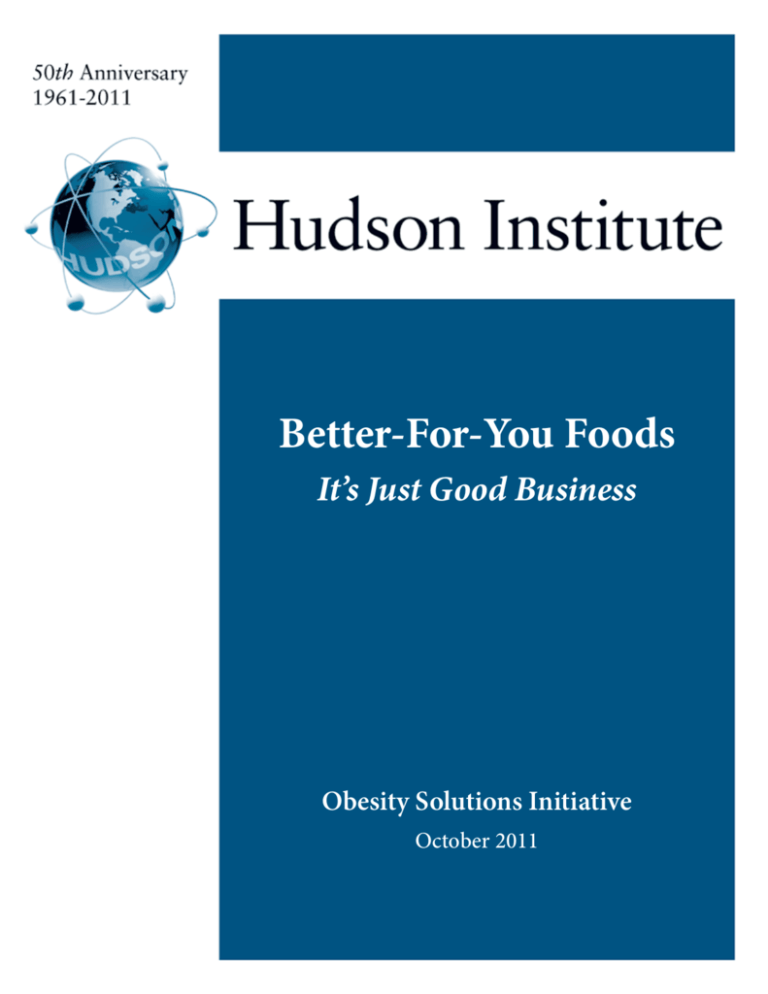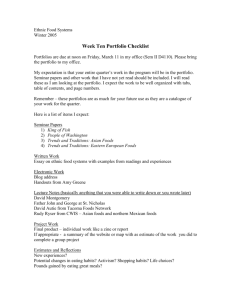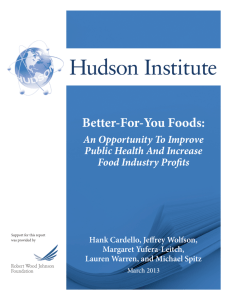Better-For-You Foods
advertisement

Better-For-You Foods It’s Just Good Business Obesity Solutions Initiative October 2011 Obesity Solutions Initiative The mission of Hudson Institute’s Obesity Solutions Initiative is to bring about practical, market-oriented solutions to the world’s obesity epidemic. The Initiative devises policies and offers market-based solutions to the global obesity epidemic by aligning the needs of all vested parties—corporations, the public health community, consumers, and regulators. Emphasis is placed on sound quantitative analysis and the incorporation of pragmatic principles to enhance adoption. The undertaking is currently focused on building the business case for better-for-you foods and beverages by quantitatively demonstrating the sales, financial, shareholder, and reputational benefits from selling larger amounts of better-for-you products. The Initiative’s director is Hudson Senior Fellow Hank Cardello, the author of Stuffed: An Insider’s Look at Who’s (Really) Making America Fat (www.stuffednation.com). He is a former food executive with Coca-Cola, General Mills, Anheuser-Busch, and Cadbury-Schweppes, and co-Chair of the Global Obesity Business Forum sponsored by the University of North Carolina at Chapel Hill. Cardello is a frequent contributor to The Atlantic on food policy and obesity matters. Assistance on this project was provided by Margaret Yufera-Leitch, Ph.D., Hudson Institute Research Associate; and Daniel Green and Madeleine Livingston. Industry perspectives and analysis were provided by Jeffrey Wolfson, Chief Marketing Officer, The FORT Group. Support for this report was provided by the Robert Wood Johnson Foundation. For more information, visit www.obesity-solutions.org Better-For-You Foods: It’s Just Good Business 1 Overview Over the past two decades, obesity rates for children and adults have grown to epidemic proportions. In 1990, no state had an obesity rate above 15 percent. Today, 38 states have obesity rates over 25 percent, and just one has a rate lower than 20 percent. The medical cost of adult obesity is estimated to be as high as $147 billion each year, and the cost to businesses due to absenteeism and lost productivity is estimated at $73 billion annually. “Making money isn’t just how a company stays afloat, but why it exists in the first place.” –AdAge, September 12, 2011 There has been great momentum by government at all levels to pass and implement laws to improve school nutrition, make communities safer for walking and biking, and increase access to affordable healthy foods. And many industry members have signaled their intent to help prevent obesity through individual efforts and in collaboration with organizations like the Partnership for a Healthier America and the Healthy Weight Commitment Foundation. However, until now, there has been little evidence for how companies can do well by doing good. In this landmark study, researchers examined Nielsen sales data from grocery stores, drug stores, and mass merchandisers; financial metrics, such as operating income, share price appreciation, and return to shareholders; and company reputation and favorability rankings to analyze whether or not sales of better-for-you (BFY) foods affect key business performance measures. For the purposes of this report, the term “foods” includes both foods and beverages. The study concluded that food and beverage companies that have a higher percentage of product sales in the BFY category perform better financially. In short, sound strategic planning with a commitment to growing sales of better-for-you foods is just good business. Consumer packaged goods (CPG) companies with a higher proportion of their sales in BFY foods demonstrate superior: • Sales growth • Operating profits • Returns to shareholders • Company reputation Selling more BFY foods can help CPG companies improve the key performance metrics demanded by their shareholders and Wall Street, while also providing more nutritious foods and beverages for parents and children. Healthier products yield healthier profits. 2 www.hudson.org Glossary Consumer Packaged Goods (CPG) Companies: companies that manufacture, market, and sell the packaged foods and beverages families buy in grocery, drug, mass merchandise, and convenience stores or in vending machines. Product examples include sodas, juices, waters, cereals, crackers, snack foods, prepared meals, and more. Sales: the dollar sales of a company or product according to Nielsen grocery, drug, and mass merchandiser data. Operating Profits: A company’s profits after accounting for its cost of goods, personnel and benefits, marketing and sales, research and development, distribution, and other direct expenses. This measure excludes noncash adjustments, such as depreciation and amortization, or interest and taxes. Total Returns: the appreciation in a shareholder’s investment, including the gain in stock price and any declared dividends. S&P 500: The S&P 500 is one of the most commonly used benchmarks tracking overall U.S. stock market performance. It is an index of 500 stocks chosen primarily for market size, liquidity and industry grouping. BrandPowerTM : a scoring and ranking system developed by CoreBrand that compares a company’s brand with its peers by measuring familiarity, favorability, reputation, quality of management, and investment potential. ”Good” Foods: products that generally are considered wholesome, for example wholegrain products, as well as traditional products that have been made healthier but do not qualify as “lite.” Better-For-You (BFY) Foods: the combination of “lite” plus “good” products. Traditional Products: those items that are not lower in calories or considered to be better for you. “Lite” Foods: foods and beverages that contain no, low, or reduced calories. Typical designations include diet, lite, and zero. Packages that contain fewer calories, such as 100-calorie packs, also are included. Key Findings Stronger Sales Growth • BFY foods drove a disproportionate share of sales growth in the past five years. Comparison Between Product Mix and Sales Growth Share of Dollar Sales and Growth 2007-2011 BFY • Between 2007 and 2011, those foods made up roughly 40 percent of sales, but generated more than 70 percent of the growth in sales—more than traditional foods. 80% • Companies that have been growing their sales of BFY items faster than sales of traditional items are delivering overall sales growth at over two times the rate. 30% Traditional Growth > BFY Foods (6 companies) Declines in Both (2 companies) 6% 71.8% 5% 61.4% 60% 3% 38.6% 28.2% 2% 20% 1% 10% 0% 0% 4.9% 4% 50% 40% % Change Dollar Sales, 2007-2011 BFY Growth > Traditional Foods (7 companies) Traditional 70% Impact of BFY on Total Company Growth Percent of $ Sales Percent of $ Sales Growth Source: Nielsen Food, Drug and Mass Merchandiser sales tracking. 2.2% -1% -2% -1.5% Source: Nielsen Food, Drug and Mass Merchandiser sales tracking. Better-For-You Foods: It’s Just Good Business 3 Higher Operating Profits • Companies with a higher percentage of sales of BFY foods are delivering superior: –– Operating profits –– Operating profit growth Average Operating Profit Margin Operating Profit Margin Growth 2007-2011 2007-2011 18% 60% 15.3% 16% 14% 40% 12% 9.5% 10% 30% 8% 4% 10% 2% 0% Above-Average BFY Portfolios (8 companies) Below-Average BFY Portfolios • Companies with a higher percentage of sales of BFY foods outperformed the S&P 500 Index by a wider margin than those with a lower percentage of such sales. • Companies with a higher percentage of sales of BFY foods delivered superior total returns to shareholders than those with a lower percentage of such sales. BFY Growth > Traditional Foods (4 companies) Source: Nielsen Data and Company Annual Reports. (Excludes beverage companies due to higher margin structure.) Superior Shareholder Returns 21.2% 20% 6% 0% 50.6% 50% (7 companies) Total Return 2007-2011 2007-2011 Point Difference vs. S&P % Total Return 70 60% 60.6 50% 50 (6 companies) Source: Nielsen Data and Company Annual Reports. (Excludes companies with declines in BFY and Traditional products.) Performance vs. S&P 500 60 Traditional Foods Growth > BFY 49.9% 40% 34.2% 39.0 40 30% 30 20% 20 10% 10 0 Above-Average BFY Portfolios Below-Average BFY Portfolios Source: S&P Index daily figures; Yahoo! Finance. 0% Above-Average BFY Portfolios Below-Average BFY Portfolios Source: Yahoo! Finance, Ycharts and Annual Reports (Nestle and Danone). 4 www.hudson.org Enhanced Reputation • Companies with a higher percentage of sales of BFY foods were rated higher on favorability and reputation. BrandPower™ Rating 80 69.5 70 60 53.2 50 40 30 20 10 0 Above-Average BFY Portfolios Below-Average BFY Portfolios Source: CoreBrand BrandPower™ ratings. Data not available for Dr. Pepper, Danone, and Smuckers. Coca-Cola and Unilever excluded as they are outliers: Coca-Cola rating = 84.6; Unilever = 9.9. Implications for Action • Placing more emphasis on selling BFY foods and beverages is an effective pathway to improved sales, profits, shareholder returns, and reputation. • Proof that bottom lines can benefit when companies have a greater percentage of sales from BFY foods could accelerate progress toward the development and marketing of more nutritious foods. • The measurement of BFY sales developed in this study should be adopted by food corporations as part of their annual sales, financial, and reputational assessments of company performance and progress. • Public health officials and policymakers need to be aware of food and beverage companies’ core business goals in order to work effectively with them to address the obesity epidemic. Better-For-You Foods: It’s Just Good Business 5 Methodology Researchers examined Nielsen sales data from grocery stores, drug stores, and mass merchandisers. A breakout of current sales by product type is shown at right. Financial metrics, such as operating income, share price appreciation and return to shareholders, and company reputation and favorability rankings also were analyzed to determine whether or not sales of BFY foods correlate with key business performance measures. Traditional Examples • Pepsi • Kellogg’s Frosted Flakes • Tropicana Orange Juice • Hellmann’s Mayonnaise Lite Foods 19.3% Traditional Foods 61.4% Researchers analyzed 15 companies, which were selected because they comprise the top tier of the largest food and beverage purveyors. Data Sources Lite Examples • Lean Cuisine • Tropicana 50 • Coca-Cola Zero • Capri Sun Roarin’ Waters Categories Total Better-For-You 38.6% Good Foods 19.3% Good Examples • Cheerios • Dannon Yogurt • Nabisco Wheat Thins • Campbell’s Tomato Soup Objectives Corporate Annual Reports Yahoo! Finance Operating Profits; S&P 500 Index; Total Return; Stock Appreciation Ycharts.com The Nielsen Company Financial Metrics Food, Drug, and Mass Merchandiser Sales Data BrandPower™ Rating Company Reputation CoreBrand BrandPower™ Ranking 1. Lite Foods The Nielsen Company; Hudson Analysis 2. Good Foods 3. Traditional Foods Product Classification








